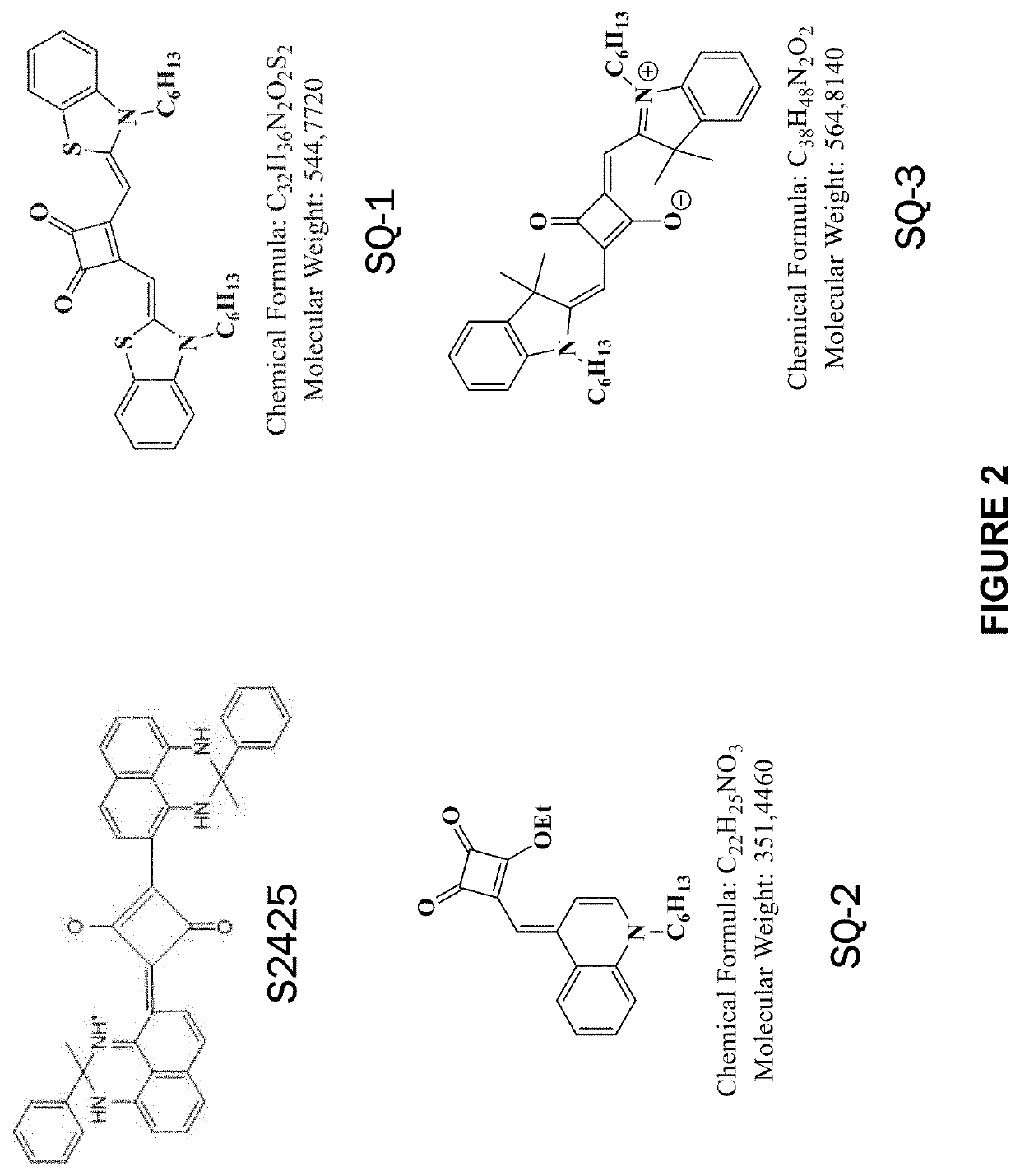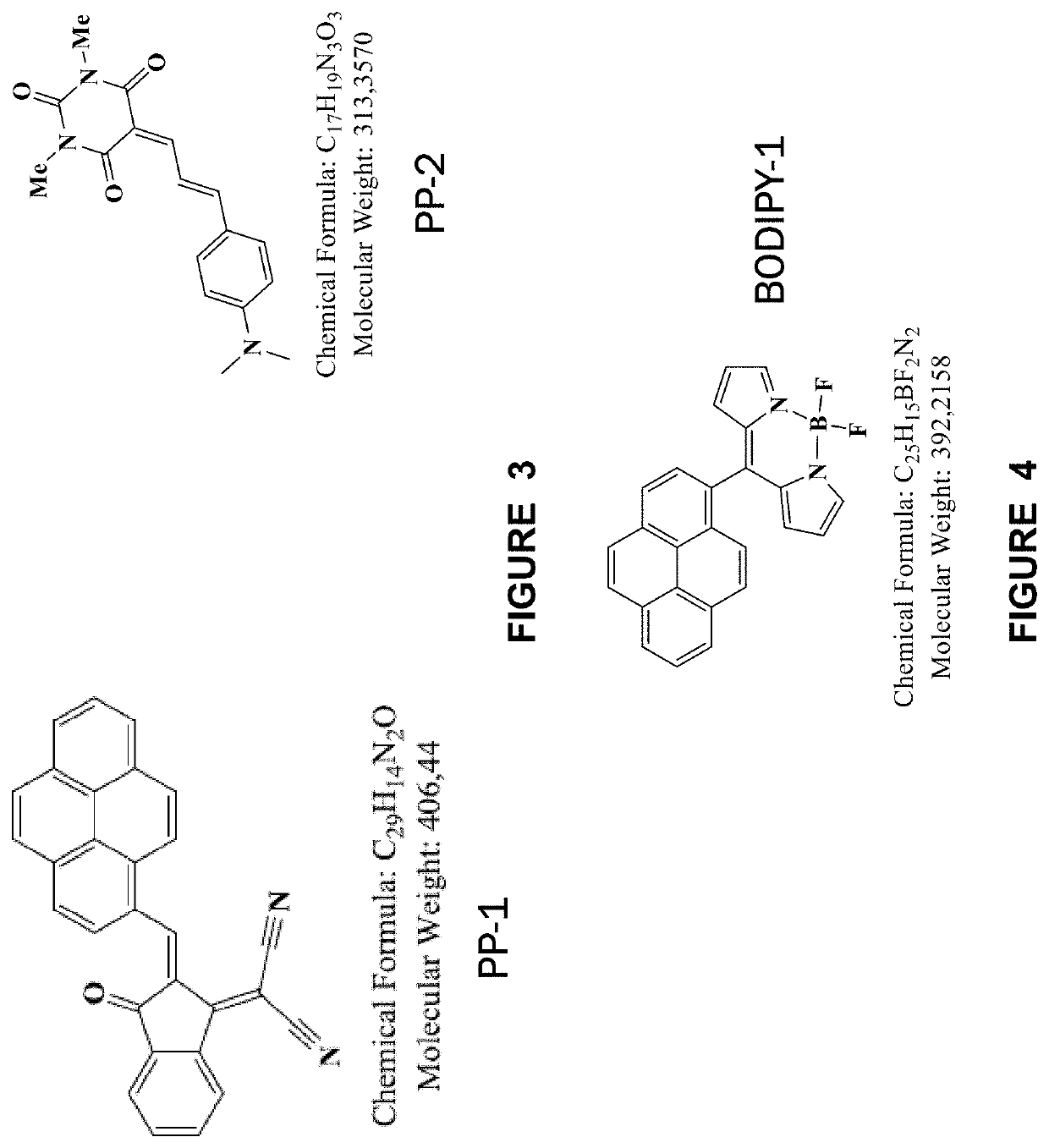Thermal amplification of free radical polymerization induced by red to near-infrared irradiation
a technology of near-infrared irradiation and free radical polymerization, which is applied in the direction of thermography, instruments, photomechanical equipment, etc., can solve the problems of poor temperature control at high conversion, need for outside energy/thermal sources, and short wavelengths that are well-known to be noxious, etc., to achieve less energy, easy modulation, and better control
- Summary
- Abstract
- Description
- Claims
- Application Information
AI Technical Summary
Benefits of technology
Problems solved by technology
Method used
Image
Examples
example 1
cal Polymerization of Methacrylates Using Heat-Generating Dyes
a) Synthesis of Exemplary NIR Borate-Dyes
[0283]Lithium triphenylbutylborate (0.770 mmol, 1.2 eq.) in water (20 mL) was added to a solution of IR-140 or IR-780 or IR-813 (0.642 mmol, 1 eq.) in a mixture of CHCl3 (100 mL) and THF (20 mL). The solution was stirred at room temperature while being protected from light for 1 hour and then set aside for 10 minutes. THF was removed under reduced pressure (still while protecting the solution from light) and the solution was transferred in a separating funnel (covered with aluminum foil). The organic phase was separated, dried over magnesium sulfate and the solvent removed under reduced pressure. Addition of THF (2 mL) followed by pentane precipitated a solid that was filtered off, washed several times with pentane and dried under vacuum. HRMS (ESI MS) m / z: theor: 679.7428 found: 679.7426 (M+ detected); HRMS (ESI MS) m / z: theor: 299.2375 found: 299.2377 (M− detected); Anal. Calc. f...
example 1.1
ty NIR Light Irradiation and 0.1 wt % of NIR-Dye
[0299]IR-780 borate dye was investigated to initiate the free radical polymerization of methacrylates upon irradiation by a laser diode at 785 nm (400 mW / cm2). The system used was a two-component system containing the dye IR-780 borate (as a light-to-heat converter noted heater; 0.1 wt %) and BlocBuilder-MA (2 wt %). Remarkably, this system gave a high polymerization rate under exposure to the NIR light (FIG. 11). Without one of the two components (IR-780 borate or BlocBuilder-MA), the polymerization is not possible. The polymerization efficiency of the different control experiments is outlined in Table 1.
[0300]
TABLE 1Polymerization results of Mix-MA under air in the presence of different initiating systems under exposure to laser diode@785 nm (400 mW / cm2) during 500 s; thickness = 1.4 mm: (+) efficient polymerization or (−) no polymerization observed.Irradiance on thesurface of the sampleSystem(W / cm2)PolymerizationPolymerizable compon...
example 1.2
[0301]The NIR laser diode used in Example 1 has a tunable irradiance from 0 to 2.55 W / cm2. The impact of the laser diode power on the maximum temperature reached by the system has been measured with IR780-borate alone (0.1 wt %) in Mix-MA (FIG. 12). No polymerization occurred without thermal initiator and no heating was observed without IR780-borate, showing that the heat released is not ascribed to polymerization but to the ability of the NIR dye to convert light to heat (heat-generating behavior). Remarkably, through incremental increases of the irradiance on the surface of the sample, the maximal temperature reached by the system also increased. The obtained maximal temperature was 45° C. using 400 mW / cm2 and over 140° C. under 2.55 W / cm2.
[0302]It was observed that the temperature reached by the sample after 100 seconds of irradiation at 785 nm was linearly correlated to the irradiance on the surface of the sample (FIG. 13). This demonstrates that it is possible...
PUM
| Property | Measurement | Unit |
|---|---|---|
| diameter | aaaaa | aaaaa |
| Temperature | aaaaa | aaaaa |
| decomposition temperature | aaaaa | aaaaa |
Abstract
Description
Claims
Application Information
 Login to View More
Login to View More - R&D
- Intellectual Property
- Life Sciences
- Materials
- Tech Scout
- Unparalleled Data Quality
- Higher Quality Content
- 60% Fewer Hallucinations
Browse by: Latest US Patents, China's latest patents, Technical Efficacy Thesaurus, Application Domain, Technology Topic, Popular Technical Reports.
© 2025 PatSnap. All rights reserved.Legal|Privacy policy|Modern Slavery Act Transparency Statement|Sitemap|About US| Contact US: help@patsnap.com



